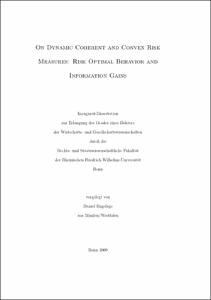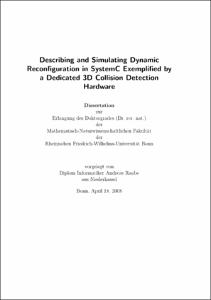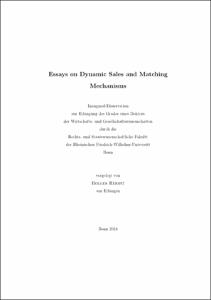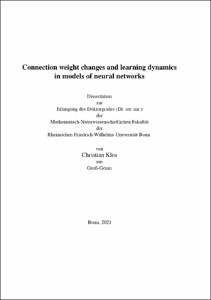On Dynamic Coherent and Convex Risk MeasuresRisk Optimal Behavior and Information Gains

On Dynamic Coherent and Convex Risk Measures
Risk Optimal Behavior and Information Gains

| dc.contributor.advisor | Riedel, Frank | |
| dc.contributor.author | Engelage, Daniel | |
| dc.date.accessioned | 2020-04-13T20:06:41Z | |
| dc.date.available | 2020-04-13T20:06:41Z | |
| dc.date.issued | 27.08.2009 | |
| dc.identifier.uri | https://hdl.handle.net/20.500.11811/4006 | |
| dc.description.abstract | We consider tangible economic problems for agents assessing risk by virtue of dynamic coherent and convex risk measures or, equivalently, utility in terms of dynamic multiple priors and dynamic variational preferences in an uncertain environment. Solutions to the Best-Choice problem for a risky number of applicants are well-known. In Chapter 2, we set up a model with an ambiguous number of applicants when the agent assess utility with multiple prior preferences. We achieve a solution by virtue of multiple prior Snell envelopes for a model based on so called assessments. The main result enhances us with conditions for the ambiguous problem to possess finitely many stopping islands. In Chapter 3 we consider general optimal stopping problems for an agent assessing utility by virtue of dynamic variational preferences. Introducing variational supermartingales and an accompanying theory, we obtain optimal solutions for the stopping problem and a minimax result. To illustrate, we consider prominent examples: dynamic entropic risk measures and a dynamic version of generalized average value at risk. In Chapter 4, we tackle the problem how anticipation of risk in an uncertain environment changes when information is gathered in course of time. A constructive approach by virtue of the minimal penalty function for dynamic convex risk measures reveals time-consistency problems. Taking the robust representation of dynamic convex risk measures as given, we show that all uncertainty is revealed in the limit, i.e. agents behave as expected utility maximizers given the true underlying distribution. This result is a generalization of the fundamental Blackwell-Dubins theorem showing coherent as well as convex risk measures to merge in the long run. | en |
| dc.language.iso | eng | |
| dc.rights | In Copyright | |
| dc.rights.uri | http://rightsstatements.org/vocab/InC/1.0/ | |
| dc.subject | Unsicherheit | |
| dc.subject | Dynamische Variationspräferenzen | |
| dc.subject | Dynamische Multiple-Prior-Präferenzen | |
| dc.subject | Dynamische Konvexe Risikomaße | |
| dc.subject | Dynamische Kohärente Risikomaße | |
| dc.subject | Dynamische Straffunktion | |
| dc.subject | Zeitkonsistenz | |
| dc.subject | Sekretärinnenproblem | |
| dc.subject | Optimales Stoppen | |
| dc.subject | Satz von Blackwell und Dubins | |
| dc.subject | Uncertainty | |
| dc.subject | Dynamic Variational Preferences | |
| dc.subject | Dynamic Multiple Prior Preferences | |
| dc.subject | Dynamic Convex Risk Measures | |
| dc.subject | Dynamic Coherent Risk Measures | |
| dc.subject | Dynamic Penalty | |
| dc.subject | Time-Consistency | |
| dc.subject | Best-Choice Problem | |
| dc.subject | Optimal Stopping | |
| dc.subject | Blackwell-Dubins Theorem | |
| dc.subject.ddc | 330 Wirtschaft | |
| dc.title | On Dynamic Coherent and Convex Risk Measures | |
| dc.title.alternative | Risk Optimal Behavior and Information Gains | |
| dc.type | Dissertation oder Habilitation | |
| dc.publisher.name | Universitäts- und Landesbibliothek Bonn | |
| dc.publisher.location | Bonn | |
| dc.rights.accessRights | openAccess | |
| dc.identifier.urn | https://nbn-resolving.org/urn:nbn:de:hbz:5-18541 | |
| ulbbn.pubtype | Erstveröffentlichung | |
| ulbbnediss.affiliation.name | Rheinische Friedrich-Wilhelms-Universität Bonn | |
| ulbbnediss.affiliation.location | Bonn | |
| ulbbnediss.thesis.level | Dissertation | |
| ulbbnediss.dissID | 1854 | |
| ulbbnediss.date.accepted | 21.08.2009 | |
| ulbbnediss.fakultaet | Rechts- und Staatswissenschaftliche Fakultät | |
| dc.contributor.coReferee | Lütkebohmert-Holtz, Eva |
Dateien zu dieser Ressource
Das Dokument erscheint in:
-
E-Dissertationen (288)







